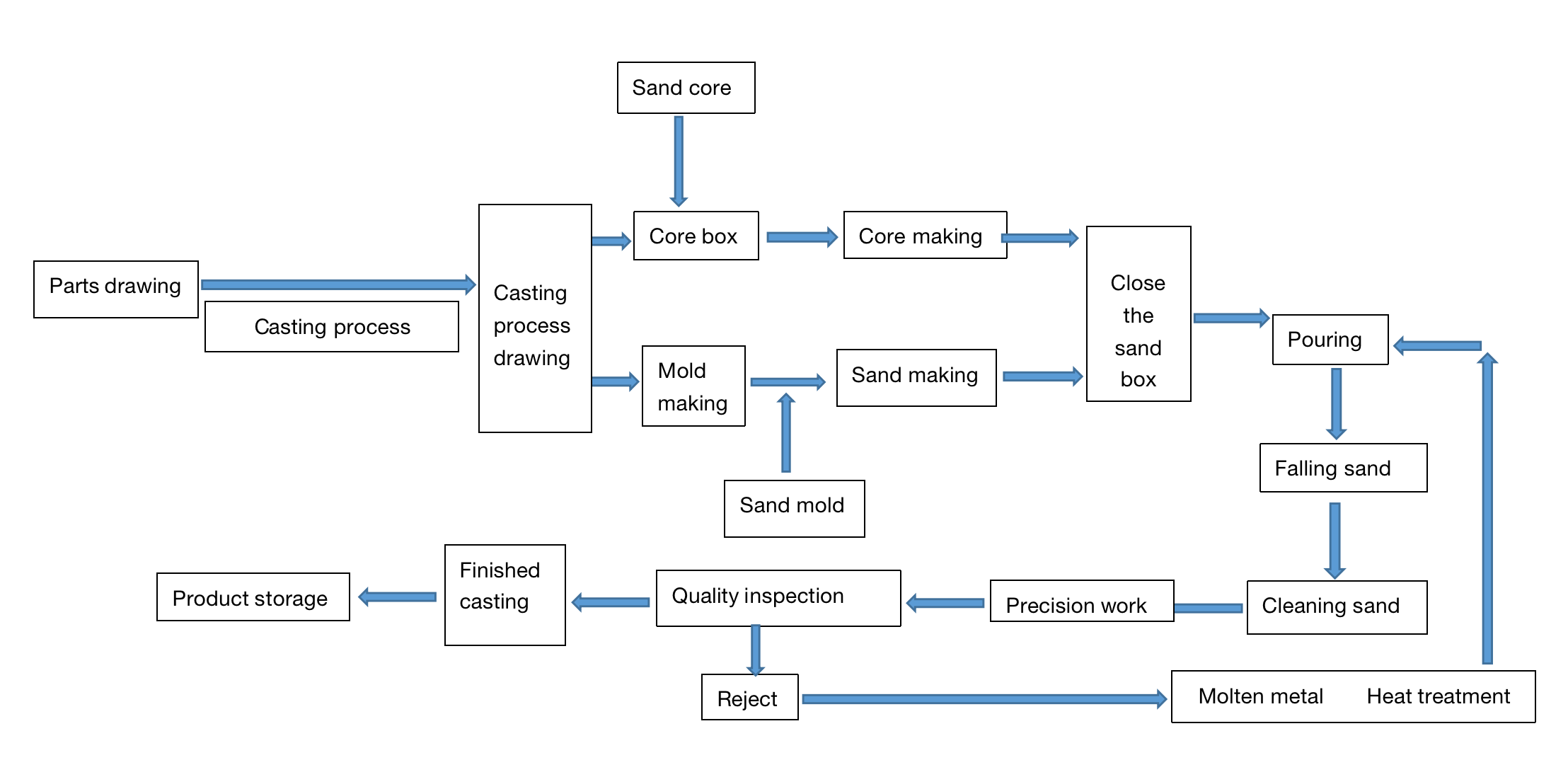
The main processes of green sand castings:
1.Mold production part: make molds according to the requirements of drawings. Generally, wooden molds can be used for single-piece production, plastic molds and aluminum molds can be made for mass production, and templates for large-scale castings can be made.
2. Sand mixing process: According to the requirements of sand mold manufacturing and different types of castings, qualified molding sand is prepared for molding.
3. Modeling (core making) process: Including modeling (using sand to form the cavity of the casting), core making (forming the internal shape of the casting), and mold matching (putting the core into the cavity, and closing the upper and lower flasks together) ). Modeling is a key link in casting.
4. Smelting process: Prepare the chemical composition according to the required metal composition, select a suitable melting furnace to melt the alloy material, and form a qualified liquid metal liquid (including qualified components and qualified temperature)
5. Pouring process: Pour the qualified molten metal into the sand box equipped with the mold. The pouring stage is very dangerous, so special attention should be paid to it.
6. Cleaning process: After the molten metal solidifies after pouring, remove the molding sand and knock out the gate and other accessories to form the required casting.
The basic raw materials for making sand molds are foundry sand and molding sand binder. The most commonly used foundry sand is siliceous sand. When the high temperature performance of silica sand cannot meet the requirements, special sands such as zircon sand, chromite sand and corundum sand are used. In order to make the sand mold and core have a certain strength and not deform or damage during handling, molding and pouring of liquid metal, a molding sand binder is generally added in the casting to bond the loose sand particles to become molding sand. The most widely used molding sand binder is clay, and various drying oils or semi-drying oils, water-soluble silicates or phosphates, and various synthetic resins can also be used as molding sand binders. The outer sand mold used in sand casting is divided into three types: clay wet sand mold, clay dry sand mold and chemical hardened sand mold according to the binder used in the molding sand and the way of building its strength.
clay wet sand
Clay and an appropriate amount of water are used as the main binder of the molding sand, and the sand mold is directly formed and poured in the wet state after it is made. Wet casting has a long history and is widely used. The strength of green sand depends on the clay slurry made by mixing clay and water in a certain proportion. Once the molding sand is mixed, it has a certain strength. After being pounded into a sand mold, it can meet the requirements of molding and pouring. , the amount of clay and moisture in the molding sand are very important process factors.
A casting method that uses molding sand and core sand as molding materials to make a mold and fills the mold with liquid metal under gravity to produce castings. Steel, iron and most non-ferrous alloy castings can be obtained by sand casting. Because the molding materials used in sand casting are cheap and easy to obtain, the casting mold is simple to manufacture, and can be adapted to single-piece production, batch production and mass production of castings, and has been the basic process in casting production for a long time.
The mold used in sand casting is generally composed of an outer sand mold and a core. In order to improve the surface quality of castings, a layer of paint is often applied to the surface of the sand mold and core. The main components of the coating are powdery materials and binders with high refractoriness and high chemical stability at high temperature. In addition, carriers (water or other solvents) for easy application and various additives are added.
Best Use For Ductile Iron Castings
Due to their increased strength and ductility, these types of castings are best used for:
- Value Bodies
- Compressor Valves
- Couplings
- Sprocket Wheels
- Hydraulic Valves & Cylinders
- Structural Brackets
- Rollers
- Cable Drums
- Frames
- Pumps
- Crankshafts
- Camshafts
- Exhaust Manifolds
- Machine frames
- Flanges
- Hubs
- Gear Boxes
Investment castings and sand mold castings foundry
Looking for a partner to assist with castings? Our team of experts work with design engineers to adequately determine the best method for part production.
OEMs can typically reduce costs up to 60% by converting to a casting. Contact Z&Z today and let us show you how.
The castings of Z&Z foundry is throughly examined by our quality assurance team.
Contact our iron foundry today to discuss a turnkey
solution for you.
Request Information
